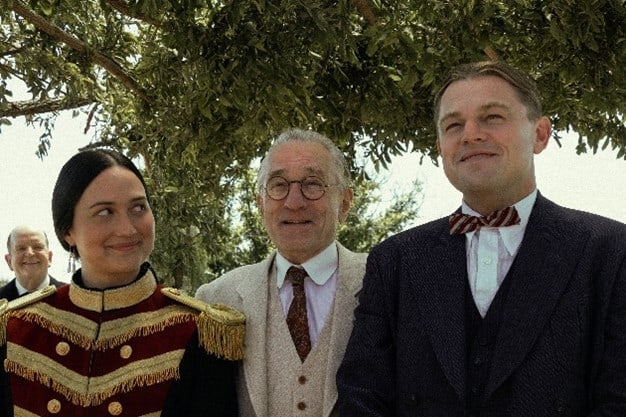By Andrew Jenck
Of all film genres, the Western has seen the most interesting evolution. Thought to be dead following the 1970s, instead it changed form, showcasing the brutal reality of its time period. Martin Scorsese takes a crack at the genre. infused with his signature storytelling of morally questionable individuals seeking satisfaction, the victims here being the Osage tribe. Based on true events, that inspired the book of the same name, the Osage are a group of Native Americans who prospered with the discovery of oil on their land, only to be targeted by white settlers marrying into their families and killing their spouses to inherit the refineries. Although a familiar pairing of the auteur director, Leonardo Di Caprio and Robert De Niro, Killers of the Flower Moon, is lively and meaningful, another stroke of mastery from Marty in this revisionist story of apathy and resilience.
Understandably, one may find the near three-and-a-half-hour runtime overwhelming, but rest assured, the film is captivating to warrant such a length. Scorsese and Eric Roth maintain attention in their script by giving each act its own distinction as the sinister scheme unfolds — the story is ever evolving. There’s some typical shot-reverse shots but the direction is diverse, creating scale fit for cinemas and capturing an intimacy within the tribe. Long-time collaborator Thelma Schoonmaker knows Marty’s intentions in and out, editing critical moments with strong emphasis and weaving all the moving pieces comprehensively. Whether viewing this in theaters or on Apple TV+ in the coming months, one should attempt to watch uninterrupted, witnessing the story flowing smoothly and see every stage of the plan as it unfolds.
De Niro plays the antagonist in a believable manner, not racist in a hateful way but more a dismissive manner. Seeing the Indigenous people’s prosperity as temporary, he justifies his actions through religious means; convincing himself he is aiding the Osage. Di Caprio, playing the main pawn, is more conflicted, caring for his Native wife with some empathy but still too willing, not challenging the views of his time and prone to manipulation for the promise of his benefit. However, the standout is Lilly Gladstone as Mollie, the Osage inheritress. Captivating with her eyes, she conveys joy, sorrow, and resilience beautifully, being paired with the Oscar winning Leo, she matches his acting caliber. The rest of the Osage cast are well invested, getting the spotlight they’d rarely see in their careers. Each victim is given a clear character with flaws but which still warrants empathy.
A systemic issue comes into play with the focus on the story. The film is very respectful of the native tribe: clothing, mannerisms, and rituals were clearly well-supported by the Osage. To be released, however, the focus is primarily on the two white actors, especially the last third of long stretches where the Osage feel absent as the FBI investigation takes center stage. One native plays a role in the investigations but could’ve had his presence highlighted more. Simultaneously, the FBI were the sole focus in the book while the script is more inclusive. Mollie and other members initiate the investigation, highlighting their drive to save their home, not relying on a white savior.
Killers of the Flower Moon demands attention for its beautiful craft and historic revisionism. Scorsese set out to tell meaningful stories in his later years and does so brilliantly, capturing the resilience of the Osage against diabolic planning while acknowledging the injustice towards the perpetrators. A respectful tribute to the Osage but shouldn’t be the only Osage story to hear; more about their culture can be found here. In spite of its limitations, Scorsese’s latest is one of the most wholistic films of the year; an experience only a veteran auteur could produce, making a strong case why such filmmakers are needed.


